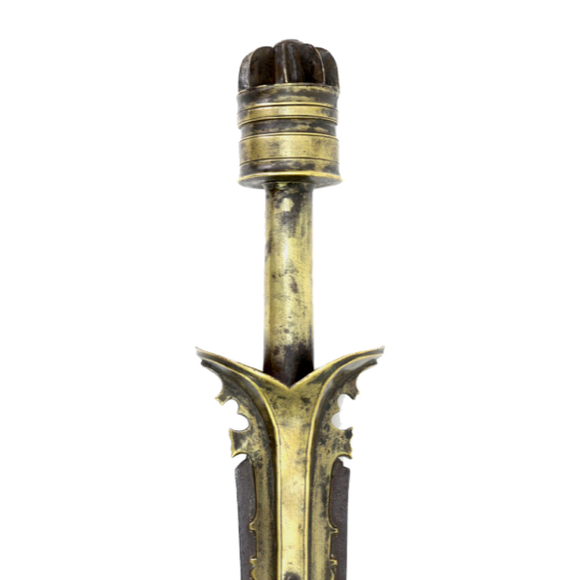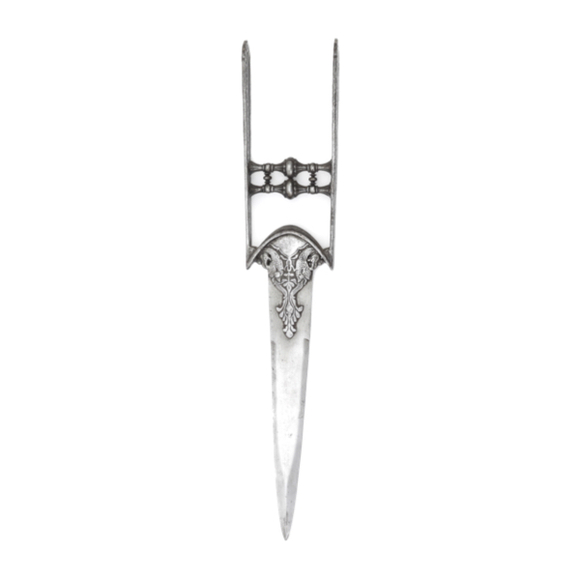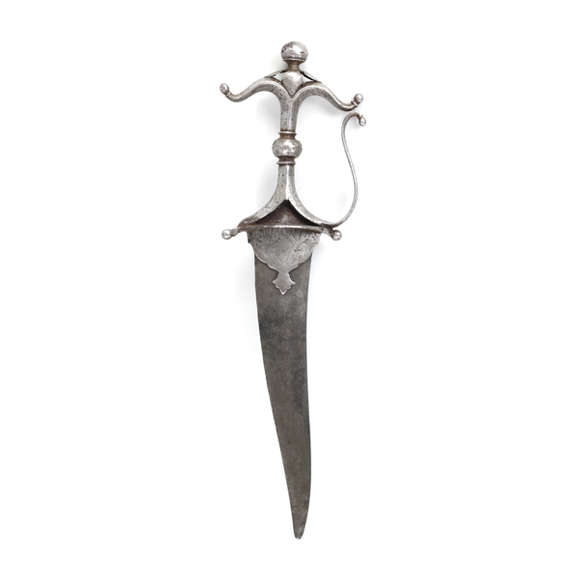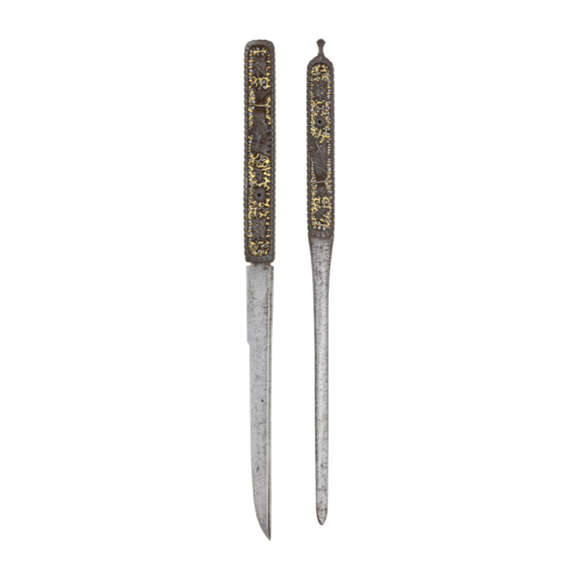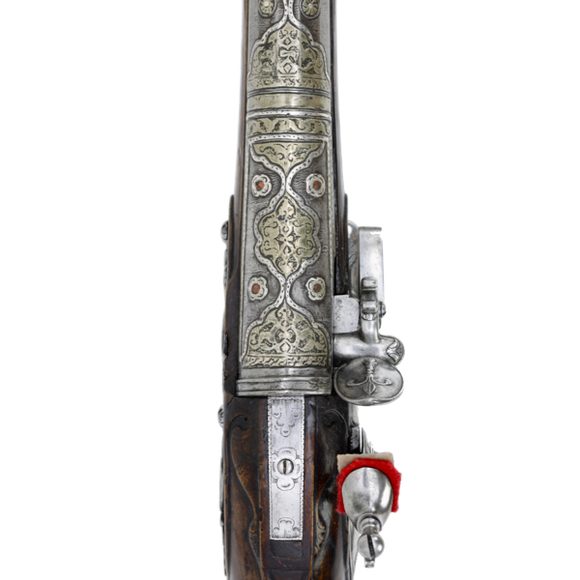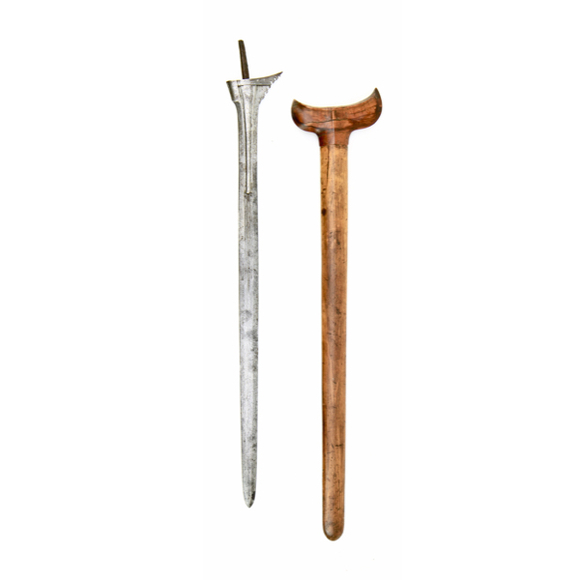An early fighting piece with strong reinforcing langet and broad, cobra shaped tip.

45.7 cm
32.3 cm
Base 5.5 mm
Tip 4.4 mm
Base 52 mm
Tip 16 mm
635 grams
At blade-hilt junction
Iron, steel
South India
Mid 17th century
Runjeet Singh
Introduction
The name chilanum first appears in Lord Egerton's Oriental Arms and Armour, describing a classic south Indian chilanum that is described as being from Vizianagaram. It is interesting to note that his entry of the name was followed by "(?)". In subsequent publications like Stone's Glossary the question mark disappears and today the name is part of the vernacular of antique arms collectors in the English speaking world.1
In the literature, we find them in the Mughal Ain-i-Akbari (Persian: آئینِ اکبری) or the "Administration of Akbar" of the 16th-century. It depicts three sheathed daggers with a chilanum-like shape, which are called khapwa, jhanbwah and bank.2
Their height of popularity was in the 16th and 17th centuries. With their very sculptural hilts, chilanum are works of art on their own. But despite this ornate appearance, the design is practical and they tend to fit the hand very well, and the all-steel construction makes them strong and durable.
A sizeable number of chilanum were captured by the armies of Maharaja Anup Singh of Bīkaner (ruled 1669-1698) at the battle of Ādoni in 1689, which subsequently wound up in the Bīkaner armory. Many remain on display at Junāgarh fort in Bīkaner today.3
Notes
1. Lord Egerton of Tatton, Indian and Oriental Arms and Armour. Dover Publications; Revised edition, 2002. Page 116.
2. Ain-i-Akbari (Persian: آئینِ اکبری) or the "Administration of Akbar"
3. For Deccan chilanum captured at Ādoni, now at Junāgarh fort in Bīkaner, see: Elgood, Robert: Hindu arms and Ritual, Eburon Publishers, Delft. Pages 178. On the exploits of Anup Singh and the battle of Ādoni, see: Goetz, Herman: Art and Architecture of the Bikaner State, Bruno Cassirer, Oxford, 1950. Pages 46-47. And: Alexander, David: Islamic Arms and Armor in the Metropolitan Museum of Art, Yale University Press, New Haven and London. Page 46.
Description
A large and very well-sculpted Deccan chilanum. The recurved blade with a marked taper in width has a sunken center panel with a grooved rib in the middle. Two grooves flank the panel, partially faded due to polishing. Chiseled into the base is the profile of an old Hindu archway.
The blade is in the bright mirror finish that these were historically kept in. I urge a future owner to keep it this way and not go and etch looking for wootz. It may well be wootz, but unless it was boldly contrasting Persian style wootz, Indians tended to keep their weapons in a mirror polish. The wootz was used for its functionality, less for its aesthetics in that time and place.
The very sculptural hilt has a guard with two stylized monster heads and a forward protruding langet strongly reminds of Persian guards. The epitome of this style is perhaps a Timurid period (1370–1507) jade sword guard in the Metropolitan Museum, accession number 02.18.765. The general design continuously saw use on pulouar swords into the 19th century.
Above this guard is a more typical guard of the Deccan chilanum, oval with a pierced, beaded rim and a bulbous element on either side. This is the base from which the stem rises that splits into the sprout-like pommel that is so characteristic of these daggers.
In the center of the stem is a ball, finely grooved as to resemble the shape of a turban. On the very top of the pommel is a large dome with a ball on top and a sharp disc right underneath it. I very much appreciate the interplay between these shapes and the heaviness of the top combined with the lightness of the thin disc.
One side of the split pommel terminates in an animal head, while the other connects to a knucklebow.
Condition
Very good condition for age with minimal pitting. Blade has seen some polishing but retained its form well, considering its age.
It comes with a custom upright stand.












Of a style often associated with Tanjore, the seat of the Vijayanagara empire.
Somewhat worn but once very high-quality, with great sculptural qualities and remains of silver "true…
The only set of its type known to me in both private and museum collections.

